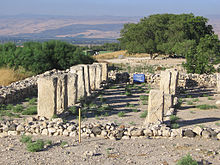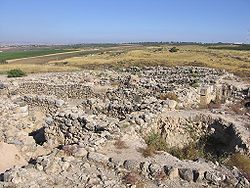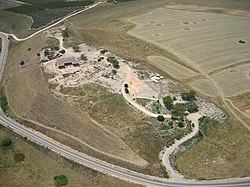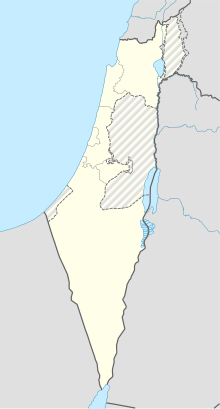Tel Hazor
תל חצור | |
 House of Pillars at Hazor | |
| Location | Tell el-Qedah, Israel |
|---|---|
| Region | Upper Galilee |
| Coordinates | 33°1′0″N 35°34′1″E / 33.01667°N 35.56694°E |
| Type | Settlement |
| History | |
| Abandoned | 732 BC |
Asia-Pacific | |
Tel Hazor (
The Hazor expedition headed by
In 2005, the remains of Hazor were designated a World Heritage Site by UNESCO as part of the Biblical Tels—Megiddo, Hazor, Beer Sheba.
Excavations

The site of Hazor is around 200 acres (0.81 km2) in area, with an upper city making up about 1/8 of that. The upper mound has a height of about 40 meters. Initial soundings were carried out by John Garstang in 1926.[6]
Major excavations were conducted for four seasons from 1955 to 1958 by a
Yadin returned to Hazor for a final season of excavation in 1968.Excavation at the site by Hebrew University, joined by the Complutense University of Madrid, resumed in 1990 under Amnon Ben-Tor. Those excavations continue to the present. The work from 1990 to 2012 is detailed in two IEF books.[12][13]
In the 2010 excavation season, two
The 2013 excavation season involved the
In total, Hazor has provided more cuneiform tablets than any other site in the Southern Levant. They fall into two groups. Those from the Middle Bronze period are in standard Old Babylonian
Finds from the dig are housed in a museum at Kibbutz Ayelet HaShahar. In 2008, some artifacts in the museum were damaged in an earthquake.[25]
Chronology
This table lists the
| Fixed date (BCE) | Archeological period | Stratum (layer) – Upper City | Stratum (layer) – Lower City | Excavation results | Historical references |
|---|---|---|---|---|---|
| 28th century | Early Bronze Age III–II | XXI | Houses | ||
| 27th century 24th century |
Early Bronze Age III | XX–XIX | Houses and a monumental structure (possibly a palace or other central building) | ||
| 22nd century 21st century |
Middle Bronze Age I/Intermediate Bronze Age | XVIII | Houses | ||
| 18th century | Middle Bronze Age IIA–B | Pre XVII | Burials and structures | Egyptian Execration Texts | |
| 18th century 17th century | Middle Bronze Age IIB | XVII | 4 | Erection of the earthen rampart of the Lower City | Mari archive |
| 17th century 16th century | Middle Bronze Age IIB | XVI | 3 | Both Upper and Lower Cities are settled. | |
| 15th century | Late Bronze Age I | XV | 2 | Both Upper and Lower Cities are settled. | Annals of Thutmose III |
| 14th century | Late Bronze Age II | XIV | 1b | Both Upper and Lower Cities are settled. | Amarna letters |
| 13th century | Late Bronze Age II | XIII | 1a | Both Upper and Lower Cities are settled. | Papyrus Anastasi I |
| 11th century | Iron Age I | XII–XI | pits and meager architecture | ||
| mid 10th century early 9th century |
Iron Age IIA | X–IX | six-chambered gate, casemate wall, domestic structures | United Kingdom of Israel (possibly under Solomon )
| |
| 9th century | Iron Age IIA–B | VIII–VII | casemate wall still used, administrative structures and domestic units | Omri dynasty )
| |
| 8th century | Iron Age IIC | VI–V | casemate wall still used, administrative structures and domestic units | Northern Kingdom of Israel (from under Tiglath-pileser III
| |
| 8th century | Iron Age IIC | IV | sporadic settlement | post–Assyrian destruction; settlement (possibly Israelite )
| |
| 7th century | Iron Age IIC (Assyrian) | III | governmental structures on and around the tell | ||
| 5th century 4th century |
Persian | II | citadel, tombs | ||
| 3rd century 1st century |
Hellenistic | I | citadel |
In a recent article (2021), Israel Finkelstein, quoting his past articles regarding stratum X in Tel Hazor (shown in the table above), commonly attributed to Solomon, states:[27]
"In past articles I proposed identifying Omride architecture. ... I therefore see no alternative to the Omride identity of Hazor X..."
Finkelstein's Low Chronology is disputed by other archaeologists, such as William G. Dever, who considers that although the "larger-than-life" portrait of the Bible is exaggerated, Judah was a centralized kingdom around 10th century BCE and likely ruled by Solomon.[28] The conventional date of stratum X in the 10th century is also supported by Amnon Ben-Tor and Shlomit Bechar, the chief excavators at the site.[29] A more nuanced position is held by Avraham Faust et al. (2021), who consider the chronological difference between Finkelstein and his opponents was already narrowed when he agreed that "not only the Iron Age IIA, but perhaps even the late Iron Age IIA, started already in the 10th century", but that most scholars have instead adopted various versions of the traditional, or modified, chronology.[30]
Among scholars who support Finkelstein's Low chronology, regarding Tel Hazor's stratum X, is Merja Alanne, which in her (2017) Doctoral dissertation, quoting late Dr. Orna Zimhoni's work (1997), writes:[31]
"Unlike Zarzegi-Peleg, Zimhoni leans towards the lower chronology and dates Megiddo VA-IVB to the 9th century, following the date of the pottery from the Jezreel enclosure. Accordingly, Hazor X−IX would also be dated to the same century."
However, other scholars such as Thomas E. Levy and Daniel Frese have noted that the evidence of the pottery from Jezreel is insufficient to support the Low chronology:[32]
"A more serious objection, made by many researchers, is that the pottery of the Iron Age IIA is basically the same for much of the 10th and 9th centuries (Ben-Tor and Ben-Ami 1998: 30; Halpern 2000: 102; Mazar and Carmi 2001: 1340; Mazar 2005: 19; Dever 2005: 75-76; Mazar 2007: 147-48). Thus, the Jezreel compound and Megiddo VA-IVB might have the same pottery, but that does not mean they both represent the 9th century."
History
Early Bronze Age
The first settlement excavated in Tel Hazor is dated to the Early Bronze Age II and III periods, existing at around the 28th and 24th centuries BCE. It was part of a system of settlements around the Hula Valley, including Abel Beth Maachah, Dan and Kedesh. The settlement was exposed in limited areas where a few houses were discovered. Based on these finds, Early Bronze Age Hazor was not a significant settlement. With that said, it seems that a large monumental structure dated to the following Middle Bronze Age period was already erected in the Early Bronze Age, sometime after the 27th century BCE. If this is true it implies that already in its beginnings, Hazor was a well-planned settlement that served as an urban center. It also shows one of the earliest examples of basalt slabs used as foundations to walls (orthostates) in the Southern Levant, only preceded by a temple from Tel Megiddo. The transition to the Early Bronze Age III period is characterized by the movement of people from rural areas within the valley to major urban sites such as Hazor, Dan and Abel Beth Maachah. Thus the establishment of a possible palace in Hazor, as well as in Dan, attest to this phenomenon.[26]
A large part of Hazor's pottery from that time belongs to the Khirbet Kerak type. A petrographic study of these vessels has shown that they were made with local clays and that Hazor played a key role in distributing them across the country. The study also showed that other types of pottery were made of a different source of local clay. This use of two different local clays for two different families of vessels might indicate a technical decision or otherwise the presence of two or more workshops. One theory suggests that the manufacturers of the Khirbet Kerak tools, which were introduced to the settlement, chose or were forced to use a different source of clay, not controlled by the other workshops. Noteworthy is the discovery of 15 cylinder seal impressions on pottery from this period, added to another found some 2 kilometers south. This assemblage is one of the largest in the southern Levant and the fact it was found in such a small excavation area further supports the reconstruction of Hazor as an important city during this period.[26]
Intermediate Bronze Age
Compared to the rest of Canaan, Hazor and Megiddo did not show signs of urban decline in the Intermediate Bronze Age. In Hazor, there was evidence of human settlements and a thriving economy, based on copper ingots and pottery from the Megiddo Ware family.[33]
In 2021, archaeologists discovered that Intermediate Bronze Age (ca. 2300-2200 BC) Hazor was preceded by years of abandonment, which started in the Early Bronze Age III (ca. 2500 BC). The latter was left in ruins but the new city built on top followed similar architectural patterns.[34]
Middle Bronze Age
During the Middle Bronze II (1820–1550 BC), Hazor was a vassal of Ishi-Addu of Qatna and his son Amutpiel II. Qatna was at the time a rival of the Great Kingdom of Yamhad centered on Aleppo, which also included Ebla and Hamath. Qatna controlled territory towards the Akkar Plain and the Beqa Valley to Hazor. However, Qatna also faced rebellions in the south, often instigated by Yamhad.
Execration texts
In Egypt, Hazor is mentioned in the execration texts.
Mari Archive
At Mari (Syria), on the Euphrates River, letters mention Hazor during the reigns of Yasmah-Adad and Zimri-Lim (1775–1761 BC).[35] Hazor is part of a trade route Hazor-Qatna-Mari. A tablet fragment was also found at Hazor which listed an expected trade path from Hazor to Mari and then on to Ekallatum.[36]

Late Bronze Age
| |||||
| ḥwḏꜣr[1][2] in hieroglyphs | |||||
|---|---|---|---|---|---|
| Era: New Kingdom (1550–1069 BC) | |||||
At the beginning of the early New Kingdom, Ahmose I started military campaigns into the southern Levant to evict the Hyksos. Several cities were attacked and more military campaigns came with Thutmose I and later Thutmose III.
Under Thutmose III Canaan was an Egyptian vassal state. In the Amarna Period, the king of Hazor (Hasura) saw its petty king Abdi-Tirshi, as swearing loyalty to the Egyptian pharaoh.

According to the

Amnon Ben-Tor of the Hebrew University of Jerusalem believes that recently unearthed evidence of violent destruction by burning verifies the Biblical account.[44] In 2012, a team led Ben-Tor and Sharon Zuckerman discovered a scorched palace from the 13th century BCE in whose storerooms they found 3,400-year-old ewers holding burned crops; Sharon Zuckerman did not agree with Ben-Tor's theory, and claimed that the burning was the result of the city's numerous factions opposing each other with excessive force.[45] More recently, Shlomit Bechar holds that a complex of cultic standing stones (matzebot) from the Iron I and Iron IIa Israelite strata at Hazor was built to commemorate the Israelite conquest of the city. She writes that, whether the Israelites did destroy Hazor or not, this complex shows that the conquest tradition probably emerged at an early date.[46]
Some Christian polemicists report that the lunar origins of Allah can be found in Hazor, which has been criticized by archaeologists.[47]
Israelite Hazor

The archaeological remains suggest that after its destruction, the city of Hazor was rebuilt as a minor village within "the territory of Naphtali" (Joshua 19:36).[49] According to the Books of Kings, the town, along with Megiddo, and Gezer, was substantially fortified and expanded by Solomon.[50] Like Megiddo and Gezer, the remains at Hazor show that during the Early Iron Age the town gained a highly distinctive six-chambered gate, as well as a characteristic style to its administration buildings; archaeologists determined that these constructions at Hazor were built by the same leadership as those at Megiddo and Gezer.[42] Many archaeologists conclude that they were constructed in the tenth century by King Solomon;[51][52] others date these structures to the early 9th century BCE, during the reign of the Omrides.[42]
Yigael Yadin, one of the earliest archaeologists to work on the site, saw certain features as clearly being Omride; Megiddo, Gezer, and Hazor, all feature deep rock cut pits, from the base of which were rock cut tunnels leading to a well that reached the water table, as water-supply systems, which Yadin attributed to the rule of Ahab; Yadin also attributed to Ahab a citadel, measuring 25 × 21 m, with two-meter thick walls, which was erected in the western part of Hazor. It has been claimed that Yadin's dating was based on the assumption that the layer connected with the gates and administration buildings were built by Solomon.[42]
Archaeological remains indicate that towards the later half of the 9th century BCE, when the king of Israel was
Israel's attempted rebellion against Assyrian domination resulted in an invasion by the forces of the Assyrian ruler, Tiglath-Pileser III; the evidence on the ground suggests that hasty attempts were made to reinforce the defenses of Hazor.[42] Despite the defences, in 732 BCE Hazor was captured, its population deported,[42][53] and the city was burnt to the ground.[42]
See also
- Archaeology of Israel
- Cities of the ancient Near East
- Early Israelite campaigns
- National parks and nature reserves of Israel
References
- ^ a b Gauthier, Henri (1927). Dictionnaire des Noms Géographiques Contenus dans les Textes Hiéroglyphiques Vol. 4. p. 24.
- ^ a b Wallis Budge, E. A. (1920). An Egyptian hieroglyphic dictionary: with an index of English words, king list and geological list with indexes, list of hieroglyphic characters, coptic and semitic alphabets, etc. Vol II. John Murray. p. 1021.
- ^ Shalev, Yiftah; Bar, Shay (2017). "An 8th Century B.C.E. Israelite Administrative Centre at Tell el-Asawir/Tel 'Esur". Zeitschrift des Deutschen Palästina-Vereins. 133 (2). Harrassowitz: 123–144. Retrieved 12 July 2021.
- ^ Killebrew, Ann E., (2005). Biblical Peoples and Ethnicity: An Archaeological Study of Egyptians, Canaanites, and Early Israel, 1300-1100 B.C.E., Society of Biblical Literature, p. 152: "Almost without exception, scholars agree that the account in Joshua holds little historical value vis-à-vis early Israel and most likely reflects much later historical times."
- ^ "Scorched Wheat May Provide Answers on the Destruction of Canaanite Tel Hazor - Biblical Archaeology Society". biblicalarchaeology.org. 2012-07-24. Retrieved 2015-09-03.
- ^ John Garstang, "History in the Bible," American Journal of Economics and Sociology, vol. 3, no. 3, Essays in Memory of Franz Oppenheimer 1864–1943, pp. 371–385, 1944
- S2CID 133750909.
- S2CID 188952326.
- S2CID 134086184.
- S2CID 135358907.
- ^ Yigal Yadin, The Fifth Season of Excavations at Hazor 1968–1969, The Biblical Archaeologist, vol. 32, no. 3, pp. 50-71, 1968
- ^ Ben-Tor, Amnon, Doron Ben-Ami, and Debora Sandhaus, Hazor VI. The 1990 - 2009 Excavations. The Iron Age. Israel Exploration Society: Institute of Archaeology, Hebrew University of Jerusalem, 2012
- ^ Ben-Tor, Amnon, Sharon Zuckerman, Shlomit Bechar, and Débora Sandhaus, HAZOR VII. The 1990-2012 Excavations. The Bronze Age, ed. Tsipi Kuper-Blau. Hebrew University of Jerusalem, Israel Exploration Society, 2017
- ^ Horowitz, Wayne, Takayoshi Oshima, and Filip Vukosavović, "Hazor 18: Fragments of a Cuneiform Law Collection from Hazor.", Israel Exploration Journal 62, pp. 158–76, 2012
- ^ Vukosavović, Filip. "THE LAWS OF HAZOR AND THE ANE PARALLELS.", Revue d’Assyriologie et d’archéologie Orientale, vol. 108, 2014, pp. 41–44
- ^ 'Hammurabi-like' cuneiform discovered at Tel Hazor - Asaf Shtull-Trauring - Jul. 27, 2010, Haaretz
- ^ Ben-Tor, Amnon, and Sharon Zuckerman., "Tel Hazor — 2013: Preliminary Report." Hadashot Arkheologiyot: Excavations and Surveys in Israel, vol. 126, 2014,
- ^ Ben-Tor, Amnon, et al., “Tel Hazor – 2014: Preliminary Report.” Hadashot Arkheologiyot: Excavations and Surveys in Israel, vol. 127, 2015
- ^ Ben-Tor, Amnon, and Shlomit Bechar., “Tel Hazor - 2015: Preliminary Report.” Hadashot Arkheologiyot: Excavations and Surveys in Israel, vol. 128, 2016
- ^ Bechar, Shlomit, and Amnon Ben-Tor., “Tel Hazor – 2016: Preliminary Report.” Hadashot Arkheologiyot: Excavations and Surveys in Israel, vol. 129, 2017,
- ^ Bechar, Shlomit, and Amnon Ben-Tor. “Tel Hazor – 2017: Preliminary Report.”, Hadashot Arkheologiyot: Excavations and Surveys in Israel, vol. 130, 2018
- ^ Bechar, Shlomit, and Amnon Ben-Tor. “Tel H̱aẕor – 2018: Preliminary Report.”, Hadashot Arkheologiyot: Excavations and Surveys in Israel, vol. 132, 2020
- ^ Bechar, Shlomit, and Amnon Ben-Tor. "Tel H̱aẕor – 2019." Hadashot Arkheologiyot: Excavations and Surveys in Israel, vol. 133, 2021
- ^ Wayne Horowitz. "Hazor: A Cuneiform City in the West." Near Eastern Archaeology, vol. 76, no. 2, 2013, pp. 98–101
- ^ "Image: a.a.0203.430.1.9.jpg, (245 × 163 px)". Haaretz. Retrieved 2015-09-03.
- ^ a b c Sharon Zuckerman (June 2013), Hazor in the Early Bronze Age, Near Eastern Archaeology, Vol 76, No. 2, pp. 68–73
- ^ Finkelstein, Israel, (2021). "Israel and Aram: Reflections on their Border", in In Search for Aram and Israel: politics, culture, and identity, pp. 17–36.
- ^ Dever, William G. (2021). «Solomon, Scripture, and Science: The Rise of the Judahite State in the 10th Century BCE». Jerusalem Journal of Archaeology 1: 102-125.
- OCLC 945028849.
- Jerusalem Journal of Archaeology1, p. 3: "The sophisticated methods of data collection and analysis that resulted from the debate significantly narrowed the chronological gap between the schools, leading most scholars to follow various versions of the traditional, or modified, chronology (e.g., Stager 2003; Mazar 2011; Katz and Faust 2014; Garfinkel et al. 2015; 2019; Dever 2017; Faust and Sapir 2018; Ortiz 2018; Master 2019), and even Finkelstein raised his chronology dramatically, agreeing that not only the Iron Age IIA, but perhaps even the late Iron Age IIA, started already in the 10th century BCE (e.g., Finkelstein and Piasetzky 2011: 51; Kleiman et al. 2019: 534-535)."
- ^ Alanne, Merja, (2017). Tel Dan: Biblical Dan An Archaeological and Biblical Study of the City of Dan from the Iron Age II to the Hellenistic Period, University of Helsinki, p. 211.
- ISBN 978-1-134-93746-2.
- S2CID 164990790.
- ^ Lev, Ron; Bechar, Shlomit; Boaretto, Elisabetta (2021). "HAZOR EB III CITY ABANDONMENT AND IBA PEOPLE RETURN: RADIOCARBON CHRONOLOGY AND ITS IMPLICATIONS". Radiocarbon. 63 (5) – via Cambridge Core.
- ^ Abraham Malamat, "Silver, Gold, and Precious Stones from Hazor" in a New Mari Document, The Biblical Archaeologist, vol. 46, no. 3, pp. 169–174, (Summer, 1983)
- ^ Horowitz, Wayne, and Nathan Wasserman. "An Old Babylonian Letter from Hazor with Mention of Mari and Ekallātum." Israel Exploration Journal, vol. 50, no. 3/4, 2000, pp. 169–74
- ^ Joshua 11:1–5, 11:10–13
- ^ Judges 4
- ^ Peake's commentary on the Bible
- ^ Jewish Encyclopedia, Book of Joshua, Book of Judges
- ^ Jewish Encyclopedia, Jabin
- ^ a b c d e f g h i Israel Finkelstein, The Bible Unearthed
- ^ [1]
- ^ Ben-tor, Amnon (2013). «Who Destroyed Canaanite Hazor?». BAR.
- ^ A 3,400-year-old mystery: Who burned the palace of Canaanite Hatzor, Haaretz
- JSTOR 26602398.
- ^ Reply To Robert Morey's Moon-God Allah Myth: A Look At The Archaeological Evidence, in mquran.org, 22 November 2006
- ^ "Tel Hazor Israelite City Gate". Madain Project. Retrieved 10 May 2020.
- ISBN 978-0-8264-1316-1(English)
- ^ 1 Kings 9:15
- ^ William G. Dever, What Did the Biblical Writers Know, and when Did They Know It? 2002 p.43
- S2CID 164757762.
- ^ 2 Kings 15:29
Further reading
- Ruhama Bonfil and Anabel Zarzecki-Peleg, "The Palace in the Upper City of Hazor as an Expression of a Syrian Architectural Paradigm," Bulletin of the American Schools of Oriental Research, no. 348, pp. 25–47, Nov 2007
- Ruhama Bonfil, "Coming before the King—A Ceremonial Basin in Hazor's Throne Room." Eretz-Israel 30 (Amnon Ben-Tor Volume): 59–72 (Hebrew), 145*–46* (English summary).
- Zarzecki-Peleg, A and Bonfil, R. (2011) "A Syrian City-State in Mitanni's Orbit?" Ugarit-Forschungen 43: 537–567
- Yadin Yigael and Et Al. Yadin, Hazor I: An Account of the First Season of Excavations, 1955, Magnes Press, 1958
- Yadin Yigael, Hazor II: An Account of the Second Season of Excavations, 1956 [James A. De Rothschild Expedition at Hazor], Oxford University Press, 1961, ISBN 978-0-19-647165-5
- Yadin Yigael, Hazor III–IV. An Account of the Third and Fourth Seasons of Excavations, 1957–1958. The James A. De Rothschild Expedition at Hazor, Biblical Archaeology Society, 1989, ISBN 978-965-221-008-1
- A. Ben Tor and ISBN 978-965-221-003-6
- Yadin Yigael, Hazor (Schweich Lectures on Biblical Archaeology), British Academy, 1972, ISBN 978-0-19-725925-2
- Yadin Yigael, Hazor: Rediscovery of a Great Citadel of the Bible, Littlehampton, 1975, ISBN 978-0-297-76845-6
- Schulamit Geva, Hazor, Israel (British Archaeological Reports (BAR)), BAR, 1989, ISBN 978-0-86054-689-4
- S. Zuckerman, "Where is the Archive of Hazor Buried?" Biblical Archaeology Review, vol. 32, pp. 28–37, 2006
- S. Zuckerman, "'...Slaying oxen and Killing Sheep, Eating Flesh and Drinking Wine...': Feasting in Late Bronze Age Hazor," Palestine Exploration Quarterly, 139,3 (2007), 186-204.
- Zarzecki-Peleg, A and Bonfil, R. (2011) "A Syrian City-State in Mitanni's Orbit?" Ugarit-Forschungen 43: 537–567
- Bonfil R. and Zarzecki-Peleg A., 2022, "'The iron which the king, my lord, gave to the smiths for work': Aspects of Authority and Prestige in the City Plan of Hazor Stratum VIII." in U. Davidovich, N. Yahalom-Mack & S. Matskevich (eds.), Material, Method, and Meaning: Papers in Eastern Mediterranean Archaeology in Honor of Ilan Sharon, Ägypten und Altes Testament, vol. 110, Zaphon, Münster, pp. 313–335



